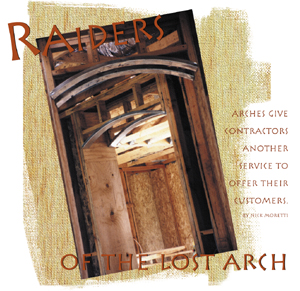
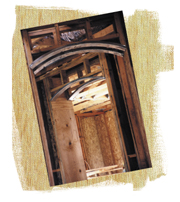
An 8,600 square foot Spanish Mediterranean house required Toby Cornell, of Cornell Custom Homes Inc., of Chino, Calif., to rethink a timely way to deliver the arches.
"This house is fairly large and there is not one long wall on the whole house," explains Cornell. "There are no squares and the entire outside perimeter of the house is all short little rounded walls. He could have saved a lot of money had he made it more square but the homeowner wanted it to look unique. This included the arches."
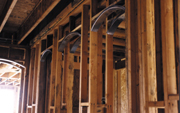
Portals of view
The arches were no surprise to Cornell's team. The plans, a couple years in the making, showed where the arches were required. Once Cornell got involved, a strategy was needed to deliver the arches. The framing was subbed to Earl Construction. Chuck Earl, owner, and Cornell agreed there was a lot of labor involved in building that many arches out of wood, the common arch material of choice in California, according to Cornell.Typical wood arch construction involves cutting two pieces of plywood with a 2x4 between them, and two workers to install it.
"The plans called for arches of 18 inches, 12 inches-thick arches," says Cornell. "Every one was different because of the variations in space sizes of the unique design of the house. Chuck could not have made a template for 40 or 50 arches quickly-he would have had to cut each one different if they were made from wood. If they were the same, it could be done with a few templates."
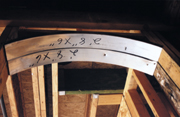
"He had different size arches and what we did in this case was we tried to use the standard arches for all the various demands of the project," Mutoh explains. "We can do custom arches but this gets a little more expensive. Since he had so many, we tried to use whatever we had."
It turned out that many of the arches had a constant radius that was non-elliptical and many of those were in stock.
"We cut the leg so it would fit the appropriate opening, meaning height of arch," Mutoh adds.
The constant radius Mutoh refers to is that most of the arches had a 6-inch height-although the lengths were different sizes. Once Cornell sent Mutoh the measurements, the arches were constructed from metal and delivered to the jobsite within a week. Each arch takes about an hour to install. There were still challenges to overcome, however.
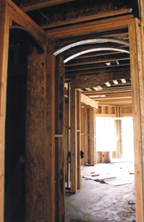
Wider arches
"On wider openings (18 inches, for example), we can't use one arch," says Cornell. "We're talking about archways that are 3 feet wide and 12 inches thick. For these applications, we used two 4-inch arches-one on one end, one on the other with drywall bridging the distance between. It can't span more than 16 inches on center. For some, we even used three metal arches. If the arch is against the wall, we only needed one."With this process, if the arch needs to be higher, it can be put up all the way against the header. Cornell asked the homeowner up front what arch height he wanted and made the header higher in advance.
"We framed a 2x4 across for header and two kickers on the end of the Easy-Arch and that completed the arch-save for a screw on top and on the side," adds Cornell. "We use three pieces of wood per arch to install. The arches installed in no time. Once they are up, drywall is attached to the arch as with any metal framing."
Cornell and the homeowner determined the extremity of each arch beforehand, as well. The homeowner didn't want a lot of deep arches. Most were six inches and a couple were 8 inches. Mutoh said Easy-Arch can do anything Cornell required in terms of arch style. If the arch was tight, a few layers of wet 1/4-inch drywall or even 1/2-inch or 5/8-inch drywall on some arches were necessary.
"Many of the arches had thick walls," Mutoh says. "Not 2x4s, but 11 inches or 15 inches. In those cases, he applied two arches on either end of the wall to account for the thicker wall. Later, he applied drywall onto the thick wall."
Wallboard is the surface of choice for the arches in terms of internal applications.
"You can put mud onto the metal itself if you wanted some ease," says Mutoh. "If there is just one arch in a curved opening, one can put mud on the arch itself. In this case, there was a little opening between arches and drywall."
